
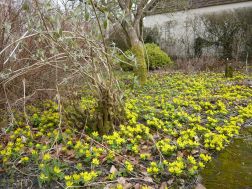

Tuesday 24th February - Timburys and Flowers of a Different Sort
An enquiry came from JW about the Timbury/Tinbury family of South Brewham and the Flower family of Chitterne. The spelling of the Timbury name is unsettled. It's not very often I get asked about the really old time families so I was excited.
In the 16/17/18th centuries, after the dissolution when most of Chitterne was no longer held by the nuns of Lacock Abbey, the Flowers were the chief tenants of the new Lords of the Manor at Chitterne St Mary: the Paulets and then the Methuens. The Flower family sub-let to the Timburys, hence the connection between the two. Now JW tells me there was an even closer connection: William Tymbury was married to John Flower's sister Margery. It's worth adding an aside here given my recent problems with the Charles Michells, in that The Flower family name was John and there were at least four of them, but not to worry as there are no Flower graves that we know about. It is frustrating that I had so little to add to what is already on the history pages of the village website, especially as JW offered me copies of some wills she has collected, which mention Chitterne, and my appetite was whetted. Wills are a great resource for the family researcher, especially the inventories, and I love deciphering the writing of the really old ones. Still, I sent what I could from my notes on the two families, including an Inquisition Post Mortem for John Flower number two who died 1624, and waited. Sometimes people never reply.
Meanwhile I've mused on what could have become of the name Timbury, or Tynburie as it is in my records. I looked up all the variations on the name in my trusty Dictionary of English Surnames, but none appear. I looked in the local telephone directory; it's always worth a look to see if there are any of that name listed, but drew another blank. The nearest I've found are the Trimbys, some of whom still live here abouts. That name does not appear in my dictionary either, so it could be a derivation, or the family could have died out.
The Flowers were still around in 1784 according to my notes, 200 years after the first John Flower gave £25 towards Queen Elizabeth's Spanish Armada fund. They were tenants at Piper's, Morgan's Hold and Rowleaze in those days, and I wish I knew where those farms with such wonderful names were, but I don't, although it's something that just might be in the wills. There are about 40 Flowers in the phone book, scattered from Bristol to Devizes and all places in between, so no danger of them dying out. Flower's Field Barn at Chitterne Ansty still exists, although someone lives in it these days.
Friday 20th February - First Flowers

| 
| 
|
Tuesday 17th February - Michell Graves
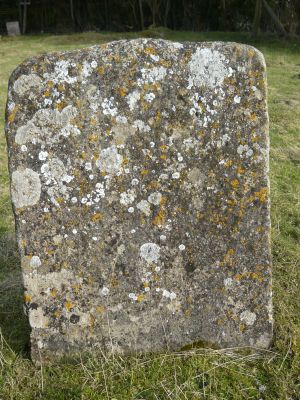 I went back to All Saints graveyard yesterday determined to get to the bottom of the Charles
Michell problem. First I checked grave number 25, pictured in previous blog, and yes, the Charles
Michell therein was definitely the one that died in 1705, of the previous generation to the
Charles, died 1720, KM was asking about. Next I checked grave 24 nearby, the Michell-Onslow vault.
This also had the same Charles
Michell, 1705, commemorated on it, but again not the Charles who died 1720. Next I checked grave
number 14, which according to my notes of 2001 should have held Charles 1720, but it was
impossible to decipher a single character of the inscription (see right). Thwarted.
I went back to All Saints graveyard yesterday determined to get to the bottom of the Charles
Michell problem. First I checked grave number 25, pictured in previous blog, and yes, the Charles
Michell therein was definitely the one that died in 1705, of the previous generation to the
Charles, died 1720, KM was asking about. Next I checked grave 24 nearby, the Michell-Onslow vault.
This also had the same Charles
Michell, 1705, commemorated on it, but again not the Charles who died 1720. Next I checked grave
number 14, which according to my notes of 2001 should have held Charles 1720, but it was
impossible to decipher a single character of the inscription (see right). Thwarted.
This graveyard has thwarted me before. It was a pain trying to make a plan of it 6 or 7 years ago, especially after the easy way the plan of Chitterne's other graveyard, St Mary's, came together. There the graves are mostly in neat lines, the boundary is roughly rectangular and the grass is kept neat and trim. But the graves in All Saints are arranged in a higgledy-piggledy fashion that makes no sense; the boundary is assymetrical, with only two straight sides and the site has no-one looking after it, just grazing sheep to keep the growth down. I even tried plotting the graves using GPS, but that didn't work when the blessed satellites kept shifting. Finally, two years later I completed the plan of All Saints by careful pacing between the graves.
Nevertheless, as I was there yesterday with a camera I decided to achieve something at least and photograph all the Michell graves, including the Michell vault, number 20, which has no monument above ground save for a modest rectangular stone inscribed: "The Vault of the Michell Family." This inscribed stone sits in the middle of a mess of fragments of broken tombstones, which litter the concrete area that defines the extent of the vault. I'm sure the sheep didn't gather the broken tombstones together and dump them there, but they may have helped create the fragments in the first place. These monuments must have once been looked upon proudly, now they are reduced to this.
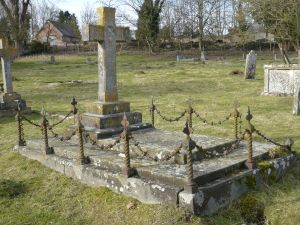 |
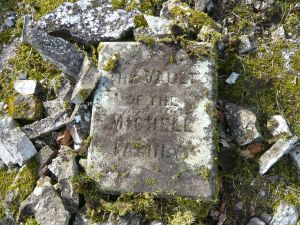 |
Sunday 15th February - When was Charles Michell Born?
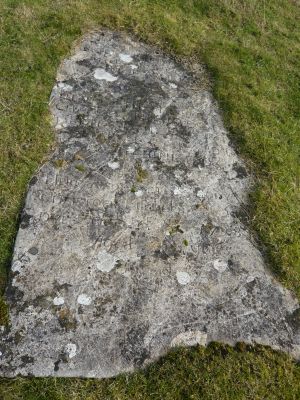
I had an interesting email from KM in Australia, a descendant of the Michell branch down under, who found my blog and kindly sent me a copy of his latest research on the Chitterne Michell branch, (I had been in touch with KM before about this). Then he added:
"The only thing that worries me is the information re Charles Michell whose birthdate I had as 1660 but I had changed that after I received your last letter in which you quoted 1671 but this date did not tally with other information that I have received and so I had trouble lining him up with the birth of his son whom I believe was born in 1689. Now if he were born in 1671 he would have only been 18 at the time of that birth?I know that that is quite possible but I, like others, think that the 1660 would have been more likely to be right so do you have any proof that 1671 is right?"
This is the thing about history research, it's never finished, it's always a work in progress. Off I went to the All Saints graveyard to check on Charles Michell. He was still there all right; his stone laying flat in the grass, emblellished by sheep and rabbit droppings and partially covered by the encroaching turf. I wished I'd brought a spade or at least a trowel but scuffing at the turf etc with my wellies had to do.
It's 8 years since I first recorded the graves in All Saints, and in that time the exposed part of the stone had worn considerably. Three deaths are recorded on the one stone and, sadly for my purposes, Charles's death is on the most exposed part in the middle. The end parts protected by the overgrowing turf are much better preserved and therefore clearer to read. However, I had remembered my camera and managed some shots when the sun obligingly appeared, see right.
Back at home I failed to find the answer to KM's question, as the crucial dates of birth and death needed were the most worn of all. This is what I could see of the inscription:
HERE LYETH THE BODY OF
CHARLES MICHELL OF THIS
PARISH HE WAS BORN
YE -- OF APRIL 16-- AND DYED
YE -2 OF JUNE 17--
Only one problem, this was the wrong Charles Michell! You know how it is, every generation had a family member named Charles and, as I keep emphasising, family history is not my strong point, but it's the subject I'm most asked about. Whatever, so where is Charles, son of Charles? Answer: I don't know. He is supposed to be buried here in Chitterne, but for the moment I am confused and I'll have to sleep on it.
Comment: I often greet many of the gravestones Hattie and I pass as we re-enter the garden from the graveyard. We have one 1st WW soldier, Harry Briggs, whom we always provide with a poppy,; and the two little children, drowned by their poor dad, in a barrel in 1910. The Power boat champion with Champion batteries carved into his stone. The gravestone maker whose two children both died young, so he had to make their stones. I would love to know some of the other stories, or make them up, but is life long enough? gg
Thursday 12th February - Spring cleaning Websites
Not a lot of email activity recently so I've been tarting up the websites, well the village one mostly. The new wider computer screens meant that the main pages of chitterne.com, that is those accessed from the main page, looked untidy on screen. The text stretching way beyond the edges of the pictures, which offended my eye. With the help of computer programmer daughter number 2 I have reined in the text to the same width as the pictures and positioned the altered pages in the middle of the screen, I hope.The news page has also been updated with snow pictures added to the News Extra feature. Oh, and I almost forgot, the cricket fixtures for the coming season have been added to the slightly tarted up Cricket Club page.
I've been asked to put on an Exhibition of old photographs during the proposed Flower Festival/Fete and Dog Show weekend this summer. Preparing the copies of the old photos will take some time, and require the assistance of D, who has his own agenda - to get fit and into training for the Trans-Alps bike race - so best to start early on the photos. I think we should be able to fit 84 photos into the space I'm allotted and that's a lot of copying.
Sunday 8th February - Ancient People at Clay Pits
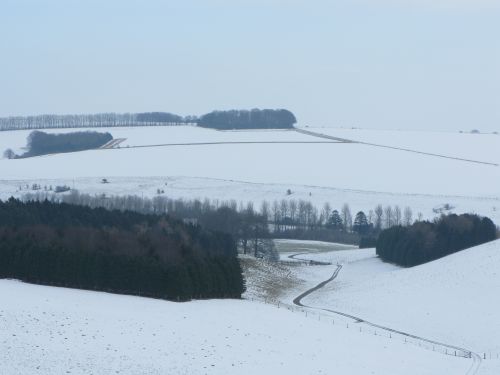
The clay pits were in use much earlier than the 17th century when the white clay was used to make tobacco pipes. Two neolithic flint tools were found at the site and nearby an old field system and an enclosure have been plotted from aerial photographs, according to the Wiltshire and Swindon sites and Monument Record. I wonder what the New Stone Age people used the clay for?
I looked up "Reading Beds" and they are beds of similar clay and sand from the Eocene period of pre-history, 30 million years ago. Southern Britain was covered in tropical vegetation and frequently flooded by the sea, which laid down beds of pebbles, sands and clays. There are smooth round pebbles still mixed with the white clay at Clay Pits. It's mind-boggling to think that they have lain there for so long. In Victorian times folk collected them to decorate their gardens much as we are doing with pebbles nowadays.
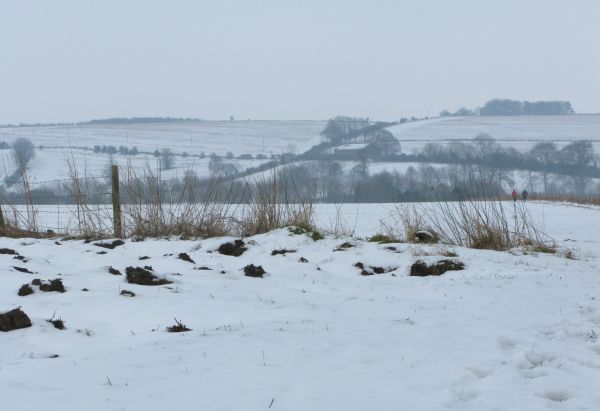
Friday 6th February - Found the Blocked Sink Hole
I sent BJ the photo (below) of Clay Pits I'd taken a few years ago when I took a descendant of one of the clay diggers to look around (See Tobacco Road under Past Writings). BJ returned with a quote from Isobel Geddes who had also visited the site some years before. It seems the clay filled the sink hole some millions of years ago, and when the rest of the clay got washed away it remained behind, which neatly explains why there is this single pocket of fine pipe-clay on top of the chalk. She says:
"Claypit Hill, Chitterne. (ST 994425). This former aggregate extraction site provides a unique occurence of sands and clays (thought to be Reading Beds) on the chalk plateau of Salisbury Plain. The strata owe their preservation by having collapsed, several m.y.(million years) ago, down into a major solution hollow in the chalk some 250m across and of unknown depth. They provide the only direct evidence of strata formerly overlying the chalk in this part of Wiltshire - the nearest Reading Beds outcrop is over 14 miles to the S.W."
So sink holes can happen in Chalk areas and they're blocked, but not by sarsens? BJ concluded by supposing that the idea of the sarsens coming from the sink hole now seems dodgy. I have no idea how you could prove something like that at the moment.
Wednesday 4th February - Chitterne Sink Hole?
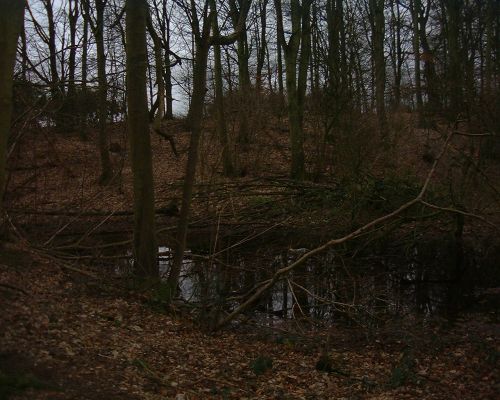
A very intriguing enquiry came yesterday by email. BJ wanted to know if I had come across the Chitterne sink hole. I had never heard of such a thing. However, he had sparked my curiosity and I did some poking around on Google.
It seems that there is controversy over the way the stones at Stonehenge got there. One faction of archeologists think some were brought from Wales and another faction think they were gathered from nearby debris deposited by the movement of ice. BJ is of the second opinion and this is where the Chitterne sink hole comes in. He says: "According to Geoff Kellaway the Chitterne sink hole (one of the deepest sink holes on the downs) was the place where the Stonehenge sarsens came from, and the sides run vertically for at least 10m." Well, (ha!) I'd heard of very deep wells in the village, some over 140ft, but not a sink hole.
To be sure what we were talking about I looked up sink hole. It is a naturally formed depression in the ground usually where underground water has worn away the soft rock causing the surface to sink. Most usually in limestone areas. So can this happen in chalk areas? I don't know and I have never heard of such a thing around here. I checked my few books on Salisbury Plain archeology and neither had sink hole in the index.
My Google search on Geoff Kellaway turned up a reference to Clay Pits. Saying that clay was dug from the top of the sink hole. Hence the picture above, which shows a pond in the middle of Clay Pits. I shall endeavour to find out more.
Monday 2nd February - Sheep Keep Warm

These pregnant Jacobs ewes in Chitterne were snuggled down in a snowy field keeping warm under their beautiful showy coats. Just the job in this cold winter weather. From the size of them it's not long to lambing time. Come summer the lambs will be growing fast and their mothers will swelter in the heat until they are sheared. The fleeces will be sold whole or spun into knitting yarn and made into great sweaters to keep humans warm. Jacobs sheepskins make excellent rugs when no longer needed by the sheep. My grandson has one alongside his cot.